One great way to see Australia is to get on to the coastal ‘choo-choo” train- The Sunlander. A thirty-one hour journey from Brisbane to Cairns- gateway to one of world’s UNESCO heritage sites- the Great Barrier Reef, turned out to be quicker than I thought, in the right company of a lively 70 year old, lady retiree.
I savoured my dinner of roast pork with crackling and finished off with tea at the mobile diner. I had time to reminiscent my past… my good, youth days in Southern England as the train traversed nostalgically through Queensland, taking on twenty-seven stops, before finally arriving Cairn’s railway station late afternoon the next day.
I was thankful to my glass of evening wine. It finally tucked me into slumber on an upper deck sleeper, my nose staring no more than eight inches from the ceiling of the train. I felt I was in a flying ghost train lying in a mobile morgue on an important mission – a rare location opportunity to chance a view of the bowerbirds – the avian Don Juans of Oz.
What are these bowerbirds that have attracted much attention and considerable amount of scientific research and literature that made these eight endemic species of Australia so special?
It is much argued by some quarters that these birds are by far, the most advanced of all birds in terms of the remarkable methods and behaviours the males used to attract the attention of the females.
Let’s check them out to see if readers would agree.
A bower is usually built with twigs and grasses fashioned into a passage archway by males on the forest floor. The shapes, sizes and methodical neatness depend on how creative males are at building to impress the females.
The entrance to the bower is further adorned with fineries of coloured objects such as sweet wrappers, flowers, moss, pebbles, seeds etc. that he would picked up and arranged over a period of time.
The bowerbird is like a landscaping architect, laying out a manicured rose garden, completing with a red carpet leading to a grand house entrance for a Romeo with means to impress his lady friend for hand in marriage… as read in fairy tale story books.
It is possible to tell the species of bowerbirds by merely looking at the bowers they built and decorate. Each has their own style depicting the variable temperament of their species with the exception of the male Tooth-billed Bowerbird (Scenepoeetes dentirostris), who build no bower of straws but displays his creativity in the form of upturned leaves plucked and scattered in a circle.
‘Wanna check your love life with a game of tarot cards, luv…?
That’s the style of the male Tooth-billed Bowerbird as he perched below a tree canopy waiting and soliciting for females.
The sole business of the male bowerbird’s existence is purely to propagate his species. He does so by maintaining his bower and wooing females during breeding season to visit his bower by call rattling from his perch, near the bower’s entrance.
A curious female would respond by showing up for an inspection of the bower. If impressed by what she saw, would be prepared to be copulated upon by the awaiting male. The female would then find herself left to build her own nest, incubate and raise the brood on her own. The male builder cum decorator takes no part in home-keeping maintenance.
The avian Don Juan simply moves on to his next beau on nature’s propagating conveyer belt so to speak, and for the female, it was simply – ‘Slam Bam, Goodbye Mam’.
The image above (left) shows a rare digitalized image of a bower built by the Golden Bowerbird Prionodura newtoniana. It was taken in a private acreage in North-Eastern Queensland.
Notice the height of the twin peaked bower which rises to just about the waistline of a European adult. The bower is also decorated with white angel hair like, moss material (above right).
For a 23-25cm bird, this master builder hits the record for building the biggest twin-tower bower amongst his cousins.
Simply massive, simply amazing!
Did I see this bird?
Yes, only a quick glimpse of a bright yellow bird fleeting in the canopy not too far from his bower. It was a sighting.
Do I know this bird?
My answer has to be No. The bird was too high up. I did not have a mental picture of exactly what the bird looked like.
It was a golden opportunity of being there at the right place, at the right time, meeting up with the right people at the right moment and perhaps, the only time and a chance in a million to witness the gigantic bower of the Golden Bowerbird and the bird itself. It was truly a golden moment in bird watching. Couldn’t ask for more.
It would be another four years later at a different location, before I finally caught up with the Satin Bowerbird (Ptilonorhynchus violaceus) to witness and document their most interesting courting behaviour played out so real.
It would put Homo sapiens to be of no match for the extraordinary effort and persuasion made by the males. It showed how fastidious and calcu- lative females can get to be and ‘ouch’ to observe a male’s knee-jerk response when rejected.
Let’s view these images and let readers be mesmerized.
It takes seven years for a male Satin Bowerbird to acquire a shiny coat of matured, blue-black plumage such as this one (left).
.
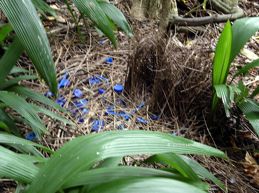
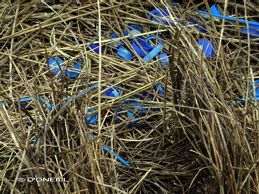
Doesn’t he look vain, arrogant and mean? His blue eyes seemed to suggest so….
The image above (left) shows an active bower with decorations at the entrance. The breeding male was observed to refresh the bower by putting up more straws, adding a different touch or so to the one foot tall arched bower.
Check out the decorations (above right). The frugivore, insectivore cum herbivore seemed to have a penchant for anything blue. A closer look showed the sedentary male has been collecting and decorating with assorted bottle caps, straws and plastic rings or just about anything that was blue, blue and blue.
The Satin Bowerbird was next observed to fly off to a nearby low branch. Perched tall at 28-34cm, he began to make noisy, wheezy and buzzy sounds and mimicry to get the attention of a female (above left).
Ten minutes later a demure, plump green bird with scaly front appeared. She was heavily streaked under throat and breast. Her eyes were as blue as the Aegean Sea (above right; left).
The female wasted no time to inspect the bower (below left).
Testosterone level simply went on overdrive for the avian Don Juan. He was observed to be quick to please and frantically offered her new beau, blue caps one after another. Could it mean metaphorically, the female even got offered a choice of male prophylaxis- Gossamer, Featherlite, lubricant or non-lubricant?
,
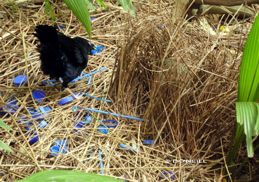
Or simply… ‘Want or not?’ (above right).
What transpired after this observation was more of an anticlimax. The female decided for whatever reason or reasons, perhaps the pigeon- hole size bower was too small for her- kind of shoddy make-shift thing, or how uncreative her suitor was or this shining male was so mean to only just provide a thrash of blues etc…, she decided to take off in a jiffy.
The immediate response from the gallant, dark and mean Satin Bowerbird was, a sudden drop of his offering of blue straw from his beak like a hot rod, leaving him aghast and sending his ego a bungee jumping! (below left).
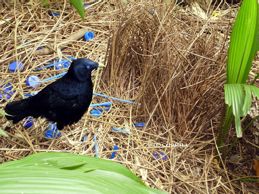
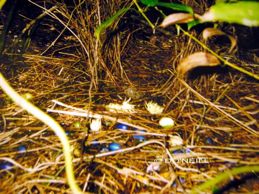
The image above (right) shows another bower of a Satin Bowerbird taken four years earlier at a different location for comparison. The male appeared to have provided attractive jungle produce of white flowers in addition to other assortment of brown and blue seeds. The bower appeared professionally weaved, neat and meticulously executed.
To this day, I am still puzzled what those almond- rocker size, blue seeds were as they smelt chocolaty and sickly sweet.
Lady readers, which bower would you choose…….?
AVIAN WRITER DAISY O’NEILL PENANG MALAYSIA
© AUSTRALIA’S OWN DON JUAN- THE BOWERBIRDS
(In respecting the wishes of owners’ privacy of private acreage properties, exact locations of these bowers are not revealed. Also, in bringing this first serial rights copy as and exclusive article for your reading pleasure, the source of all writing materials upon which Avian Writer obtains from is of no obligation to mention. Kindly refrain from asking. Thank you.)




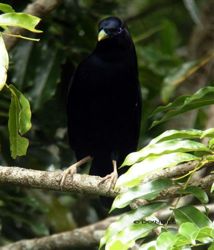

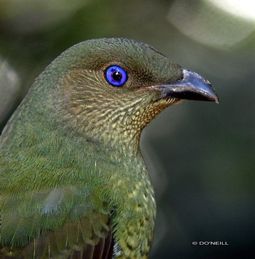
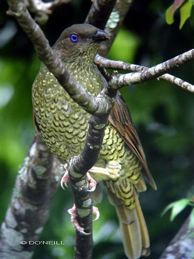







3 Responses
I have a short encounter with a female Satin bowerbird. There are a few photos on this link to my blog.
http://chenghiang.wordpress.com/2008/11/05/satin-bowerbird-ptilonorhynchus-violaceus/